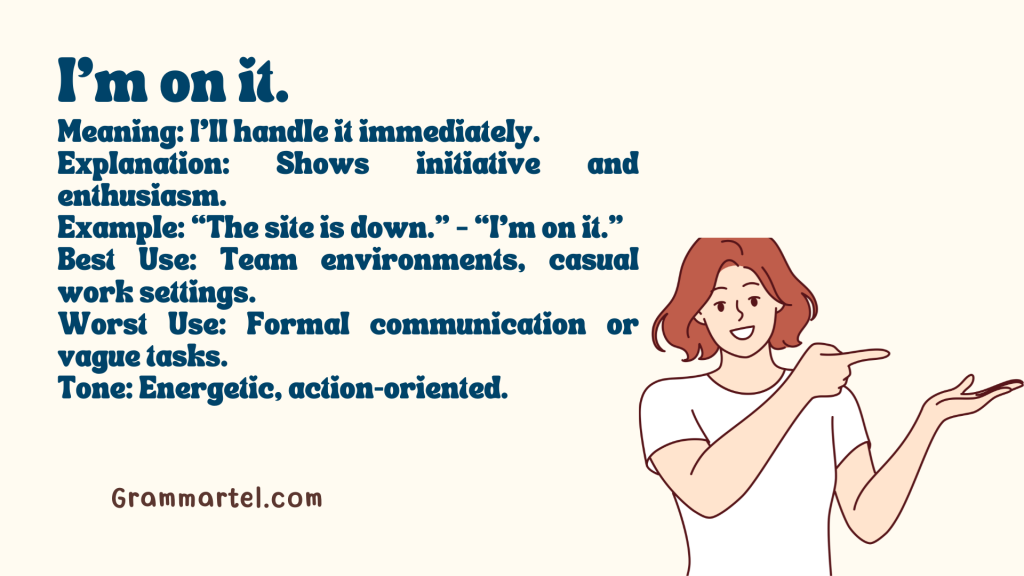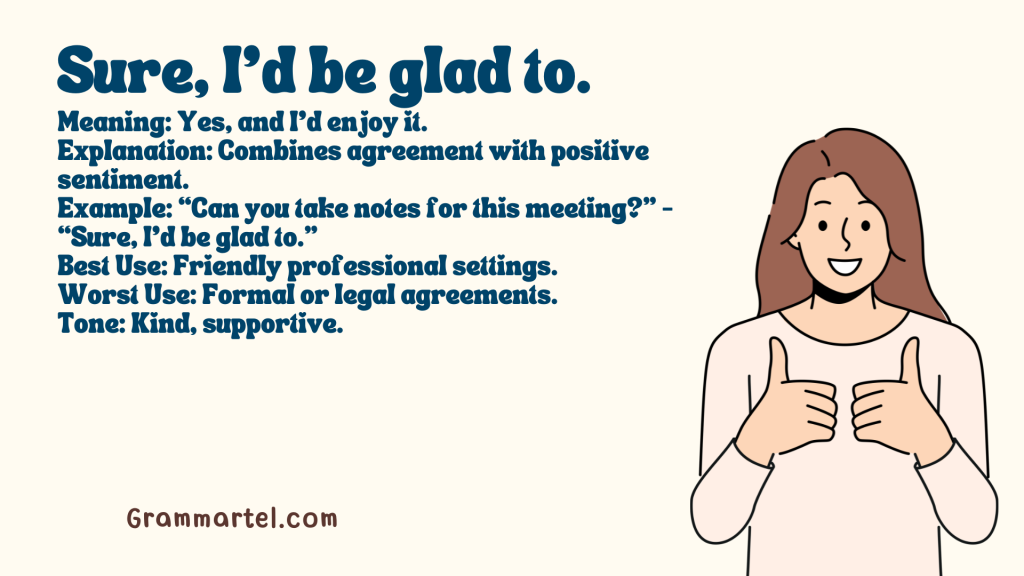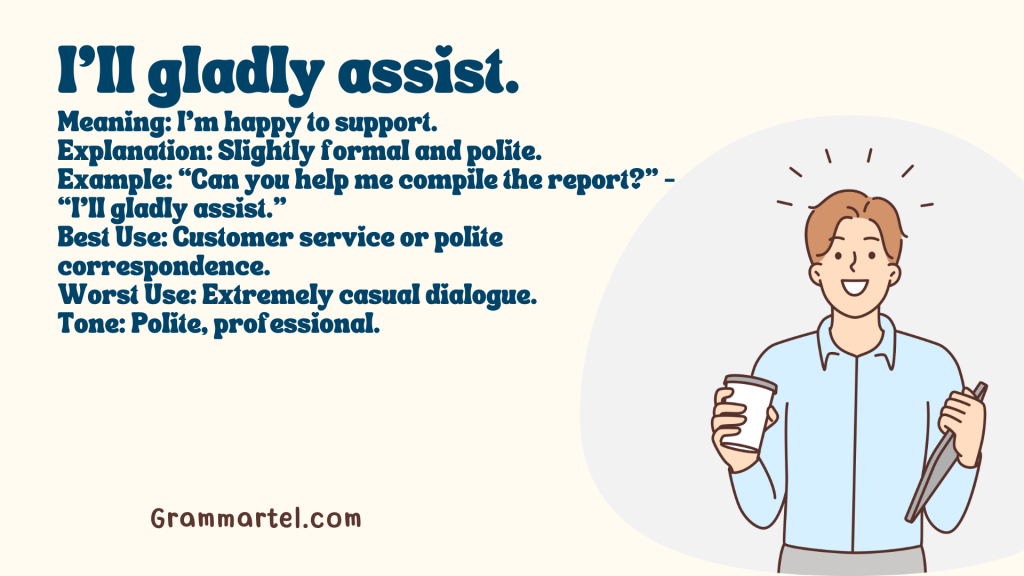When someone asks for your help or a favor, it’s nice to say “I’d be happy to.” But sometimes, saying the same thing over and over can feel a bit repetitive. Luckily, there are many other ways to express the same sentiment! In this article, we’ll explore 40 different ways to say “I’d be happy to,” including examples to make your responses more engaging and varied.
What Does “I Would Be Happy To” Mean?
The phrase “I would be happy to” is a polite and positive way to express willingness or eagerness to do something. It implies that the speaker is offering help, agreeing to a request, or showing enthusiasm about an action they are being asked to perform. The phrase conveys a sense of readiness and willingness, often coupled with a tone of goodwill or pleasantness. It’s a way of saying that you’re not just capable of doing something, but also that you would enjoy or find pleasure in doing it.
When to Use “I Would Be Happy To”
You should use the phrase “I would be happy to” in situations where you want to politely agree to a request or offer assistance. It’s particularly useful in formal, professional, or courteous conversations, but can also be used in everyday situations when you want to show enthusiasm for helping someone or participating in an activity.
Here are some common scenarios where it’s appropriate to use this phrase:
- Offering Help or Assistance: When someone asks for help or a favor, you can say, “I would be happy to help.”
- Agreeing to Participate: If you’re invited to an event or asked to participate in something, saying “I would be happy to join” sounds friendly and positive.
- Professional Settings: In a workplace or formal context, you can use this phrase to show willingness to take on a task or responsibility in a courteous way.
- When You’re Eager: If you are particularly excited or pleased to be involved in something, it’s a great way to express your enthusiasm.
In essence, “I would be happy to” is a versatile phrase that communicates both your readiness and enthusiasm for doing something, while maintaining politeness and respect.
40 Different Ways to Say “I’d Be Happy To” (Examples Included)
1. Of course!
Meaning: Absolutely, yes.
Explanation: A quick and enthusiastic way to agree.
Example: “Can you help me move the boxes?” – “Of course!”
Best Use: Casual conversations, friendly settings.
Worst Use: Highly formal or professional emails.
Tone: Warm, informal.
2. Certainly.
Meaning: I will do that with no hesitation.
Explanation: A polite and professional way to say yes.
Example: “Can you forward me the document?” – “Certainly.”
Best Use: Business emails, customer service.
Worst Use: Informal chats with friends.
Tone: Polite, formal.
3. Absolutely!
Meaning: Yes, enthusiastically.
Explanation: Strongly affirmative and energetic.
Example: “Would you like to join our team dinner?” – “Absolutely!”
Best Use: Friendly workplace, casual settings.
Worst Use: Formal written communication.
Tone: Upbeat, enthusiastic.
4. No problem at all.
Meaning: I’m happy to help.
Explanation: Downplays the difficulty, reassures the other person.
Example: “Thanks for helping me last minute.” – “No problem at all.”
Best Use: Informal support, casual work environment.
Worst Use: Legal or formal commitments.
Tone: Friendly, relaxed.
5. It would be my pleasure.
Meaning: I’d enjoy doing that for you.
Explanation: Shows willingness and grace.
Example: “Would you be able to host the meeting?” – “It would be my pleasure.”
Best Use: Hospitality, customer service, formal emails.
Worst Use: Texting friends or peers casually.
Tone: Gracious, formal.
6. Glad to!
Meaning: Yes, I’d enjoy that.
Explanation: Casual and cheerful agreement.
Example: “Can you review this for me?” – “Glad to!”
Best Use: Friendly workplace, peer-to-peer.
Worst Use: High-stakes negotiations or legal contexts.
Tone: Casual, upbeat.
7. Happy to help.
Meaning: I’m available and willing to assist.
Explanation: Common phrase that conveys support.
Example: “Thanks for your quick reply.” – “Happy to help.”
Best Use: Support roles, emails, informal settings.
Worst Use: If deeper responsibility is required.
Tone: Supportive, professional.
8. With pleasure.
Meaning: I’d enjoy doing it.
Explanation: Elegant way to accept a request.
Example: “Could you bring this to the client?” – “With pleasure.”
Best Use: Formal service, polite environments.
Worst Use: Among close friends (may sound stiff).
Tone: Polite, refined.

9. I’m on it.
Meaning: I’ll handle it immediately.
Explanation: Shows initiative and enthusiasm.
Example: “The site is down.” – “I’m on it.”
Best Use: Team environments, casual work settings.
Worst Use: Formal communication or vague tasks.
Tone: Energetic, action-oriented.
10. Definitely.
Meaning: For sure.
Explanation: Strong yes, informal.
Example: “Can I count on you for that call?” – “Definitely.”
Best Use: Friendly agreement.
Worst Use: When detailed confirmation is needed.
Tone: Confident, casual.
11. Sure thing!
Meaning: Absolutely, I’ll do that.
Explanation: Informal way to confirm you’re willing to help.
Example: “Can you email that later?” – “Sure thing!”
Best Use: Friendly exchanges, internal team chat.
Worst Use: Business contracts or executive emails.
Tone: Casual, friendly.
12. You got it!
Meaning: Consider it done.
Explanation: A confident way to accept a request.
Example: “Could you send those numbers over?” – “You got it!”
Best Use: Collaborative teams, informal talks.
Worst Use: When speaking with higher-ups or external clients.
Tone: Assertive, casual.
13. Absolutely, I can do that.
Meaning: Yes, with certainty.
Explanation: Clear and positive agreement.
Example: “Can you take over this task?” – “Absolutely, I can do that.”
Best Use: Work conversations, polite but direct.
Worst Use: Very formal writing.
Tone: Enthusiastic, respectful.
Similiar Reads: 40 Alternative Ways to Say “I’m Not Feeling Well” (With Examples)
14. I’d love to.
Meaning: I genuinely want to.
Explanation: Shows eagerness and warmth.
Example: “Want to join our planning session?” – “I’d love to.”
Best Use: Invites, collaborative efforts.
Worst Use: Tasks you don’t actually enjoy.
Tone: Warm, personal.
15. Not a problem.
Meaning: I’m willing, and it’s no trouble.
Explanation: Reassures that the request is easy to fulfill.
Example: “Sorry to ask again—can you help?” – “Not a problem.”
Best Use: Informal or repeated requests.
Worst Use: Formal occasions or serious situations.
Tone: Laid-back, reassuring.
16. Count me in.
Meaning: I’m joining or participating.
Explanation: Expresses enthusiasm to be included.
Example: “We need someone for the outreach team.” – “Count me in.”
Best Use: Group efforts, voluntary actions.
Worst Use: Tasks you’re obligated to do.
Tone: Cheerful, enthusiastic.

17. Sure, I’d be glad to.
Meaning: Yes, and I’d enjoy it.
Explanation: Combines agreement with positive sentiment.
Example: “Can you take notes for this meeting?” – “Sure, I’d be glad to.”
Best Use: Friendly professional settings.
Worst Use: Formal or legal agreements.
Tone: Kind, supportive.
18. I’ll take care of it.
Meaning: I’ll handle that for you.
Explanation: Offers assurance and initiative.
Example: “Can someone handle the printouts?” – “I’ll take care of it.”
Best Use: Taking ownership, quick solutions.
Worst Use: When you lack authority to act.
Tone: Confident, helpful.
19. Leave it to me.
Meaning: I’ll handle this personally.
Explanation: Suggests capability and responsibility.
Example: “We need someone to coordinate logistics.” – “Leave it to me.”
Best Use: Task delegation, trusted roles.
Worst Use: When your role isn’t clear.
Tone: Assured, helpful.
20. I’m happy to jump in.
Meaning: Willing to help immediately.
Explanation: Shows readiness to assist actively.
Example: “We need extra help for this event.” – “I’m happy to jump in.”
Best Use: Team efforts, spontaneous support.
Worst Use: Solo responsibilities or formal tasks.
Tone: Energetic, team-oriented.
21. Consider it done.
Meaning: It’s as good as completed.
Explanation: Expresses certainty and competence.
Example: “Can you schedule that appointment?” – “Consider it done.”
Best Use: Tasks you’re confident in handling.
Worst Use: Overpromising or tasks outside your control.
Tone: Confident, decisive.
22. I’m willing to help.
Meaning: I’ll support you.
Explanation: Open offer to assist.
Example: “Do you need someone to troubleshoot?” – “I’m willing to help.”
Best Use: Teamwork and when offering voluntarily.
Worst Use: When you’re expected to do it regardless.
Tone: Supportive, neutral.
23. Let me know what you need.
Meaning: I’m here to help—just ask.
Explanation: Flexible offer of assistance.
Example: “This project is a lot.” – “Let me know what you need.”
Best Use: Leadership, collaborative roles.
Worst Use: When someone needs direct action, not a question.
Tone: Supportive, open-ended.
24. Always glad to help.
Meaning: Helping you is never a burden.
Explanation: A polite expression of continuous willingness.
Example: “Thanks for reviewing it again.” – “Always glad to help.”
Best Use: Ongoing collaboration.
Worst Use: When you’re burned out or overworked.
Tone: Cheerful, polite.
25. At your service.
Meaning: I’m here to assist you.
Explanation: Formal or stylized way of offering help.
Example: “Could you support our client today?” – “At your service.”
Best Use: Service-oriented roles or stylized communication.
Worst Use: Informal team discussions.
Tone: Formal, charming.

26. I can take that on.
Meaning: I’ll handle that task.
Explanation: Willingness to assume responsibility.
Example: “Someone needs to draft the plan.” – “I can take that on.”
Best Use: Delegation, collaborative projects.
Worst Use: When you lack time or capacity.
Tone: Cooperative, proactive.
27. I’m more than happy to.
Meaning: I’d be very pleased.
Explanation: Emphasizes willingness.
Example: “Can you cover my shift Friday?” – “I’m more than happy to.”
Best Use: Friendly or gracious exchanges.
Worst Use: If you feel coerced into helping.
Tone: Warm, generous.
28. I’ll be there.
Meaning: I’ll show up or participate.
Explanation: A solid commitment.
Example: “Can you attend the feedback session?” – “I’ll be there.”
Best Use: Scheduling, teamwork.
Worst Use: When more is expected than attendance.
Tone: Reliable, clear.
29. That works for me.
Meaning: I’m fine with that.
Explanation: Shows agreement and ease.
Example: “Can we meet at 10?” – “That works for me.”
Best Use: Scheduling or planning.
Worst Use: Accepting complex tasks.
Tone: Flexible, agreeable.
30. I’d be honored.
Meaning: It’s a privilege for me.
Explanation: Respectful and appreciative tone.
Example: “Would you like to present the award?” – “I’d be honored.”
Best Use: Invitations, recognition, ceremonies.
Worst Use: Minor tasks or casual requests.
Tone: Formal, humble.
31. I can handle that.
Meaning: I’m capable of doing it.
Explanation: Offers confidence in your abilities.
Example: “Who can manage the setup?” – “I can handle that.”
Best Use: Technical or logistical roles.
Worst Use: If you lack the needed skills.
Tone: Capable, reassuring.
32. Let me take care of that.
Meaning: I’ll do it for you.
Explanation: Warm offer to ease someone’s load.
Example: “I haven’t had time to update the list.” – “Let me take care of that.”
Best Use: Supportive situations, team dynamics.
Worst Use: When it oversteps someone’s authority.
Tone: Kind, helpful.
33. I’ve got you covered.
Meaning: I’ll handle it so you don’t have to.
Explanation: Reassuring, protective statement.
Example: “I need to step out for a bit.” – “I’ve got you covered.”
Best Use: Team-based, dependable roles.
Worst Use: If it sounds dismissive.
Tone: Reassuring, informal.
34. Sounds good, I’m in.
Meaning: I agree and I’ll do it.
Explanation: Shows agreement and willingness.
Example: “Want to work on this project together?” – “Sounds good, I’m in.”
Best Use: Casual team settings.
Worst Use: Formal communications.
Tone: Friendly, energetic.

35. I’ll gladly assist.
Meaning: I’m happy to support.
Explanation: Slightly formal and polite.
Example: “Can you help me compile the report?” – “I’ll gladly assist.”
Best Use: Customer service or polite correspondence.
Worst Use: Extremely casual dialogue.
Tone: Polite, professional.
36. Let me help with that.
Meaning: I’ll join in to support.
Explanation: An offer that shows you’re engaged.
Example: “I’m trying to sort this data.” – “Let me help with that.”
Best Use: Shared tasks or cooperative environments.
Worst Use: Overstepping or unsolicited help.
Tone: Helpful, warm.
37. I’ll pitch in.
Meaning: I’ll contribute.
Explanation: Implies shared responsibility or teamwork.
Example: “We need to tidy up before the event.” – “I’ll pitch in.”
Best Use: Group projects, quick tasks.
Worst Use: When the work is individual.
Tone: Cooperative, casual.
Must See: 40 Ways to Say “Please Accept My Apologies (Including Examples)
38. I’m game.
Meaning: I’m open to it.
Explanation: Slang-like way to say you’re willing.
Example: “Want to try this new approach?” – “I’m game.”
Best Use: Creative teams or brainstorming.
Worst Use: Highly professional settings.
Tone: Playful, open-minded.
39. Just say the word.
Meaning: I’m ready to act as soon as you ask.
Explanation: Offers immediate readiness.
Example: “We might need backup on this call.” – “Just say the word.”
Best Use: Trusted working relationships.
Worst Use: Formal writing.
Tone: Loyal, confident.
40. You can count on me.
Meaning: I’m reliable and ready to help.
Explanation: Reinforces trust and dependability.
Example: “This task is crucial.” – “You can count on me.”
Best Use: Critical responsibilities or emotional support.
Worst Use: If you’re unsure of your availability.
Tone: Trustworthy, sincere.
Conclusion
Having a variety of ways to express “I’d be happy to” can make your conversations more lively and interesting. Whether you’re helping a friend or offering support at work, these alternatives show you’re eager and willing. A little creativity in your language can make your responses feel more personal and thoughtful. Elevate your content and captivate readers with Grammartel.

